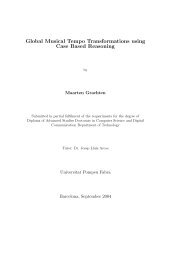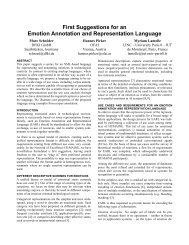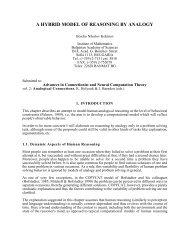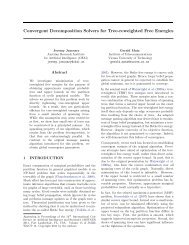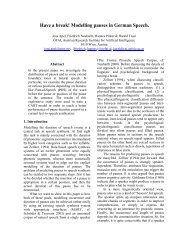Computational Models of Music Similarity and their ... - OFAI
Computational Models of Music Similarity and their ... - OFAI
Computational Models of Music Similarity and their ... - OFAI
Create successful ePaper yourself
Turn your PDF publications into a flip-book with our unique Google optimized e-Paper software.
26 2 Audio-based <strong>Similarity</strong> Measures<br />
a classifier <strong>and</strong> is the main weak-point. To be able to describe a broad<br />
range <strong>of</strong> music a huge amount <strong>of</strong> clusters is necessary. Furthermore, there<br />
is no guarantee that music not used to train the clusters can be described<br />
meaningfully.<br />
The first localized approach was presented by Logan <strong>and</strong> Salomon [LS01].<br />
For each piece an individual set <strong>of</strong> clusters is used. The distances between<br />
these are computed using the Kullback-Leibler Divergence combined with<br />
the Earth Movers Distance [RTG00].<br />
Aucouturier <strong>and</strong> Pachet suggested using the computationally more expensive<br />
Monte Carlo sampling instead [AP02a; AP04a]. A simplified approach<br />
approach using a fast approximation <strong>of</strong> the Monte Carlo sampling<br />
was presented in [Pam05]. M<strong>and</strong>el <strong>and</strong> Ellis [ME05] propose an even simpler<br />
approach using only one cluster per piece <strong>and</strong> comparing them using<br />
the Kullback-Leibler Divergence. All three are described in detail in this<br />
subsection.<br />
Alternative techniques to compute spectral similarity include, for example,<br />
the anchor space similarity [BEL03], the spectrum histograms [PDW03a],<br />
or simply using the mean <strong>and</strong> st<strong>and</strong>ard deviations <strong>of</strong> the MFCCs (e.g. [TC02]).<br />
2.2.3.2 Thirty Gaussians <strong>and</strong> Monte Carlo Sampling (G30)<br />
This approach was originally presented in [AP02a]. Extensive evaluation<br />
results were reported in [AP04a]. A Matlab implementation based on these<br />
won the ISMIR 2004 genre classification contest [Pam04]. 12<br />
The approach consists <strong>of</strong> two steps. These are clustering the frames <strong>and</strong><br />
computing the cluster model similarity. First, the various spectra (frames<br />
represented by MFCCs) which occur in the piece are summarized (i.e., the<br />
distribution is modeled) by using a clustering algorithm to find typical spectra<br />
(cluster centers) <strong>and</strong> describing how typical they are (prior probabilities),<br />
<strong>and</strong> how the other spectra vary with respect to these few typical spectra<br />
(variances).<br />
Second, to compute the distance between two pieces, the distribution <strong>of</strong><br />
<strong>their</strong> spectra are compared. If two pieces have similar distributions (i.e.,<br />
if <strong>their</strong> spectra can be described using similar typical spectra, with similar<br />
variances, <strong>and</strong> priors) they are assumed to be similar.<br />
Frame Clustering<br />
The frames are clustered using a Gaussian Mixture Model (GMM) <strong>and</strong> Expectation<br />
Maximization (see e.g. [Bis95]). GMMs are a st<strong>and</strong>ard technique<br />
12 http://ismir2004.ismir.net/genre contest/index.htm




